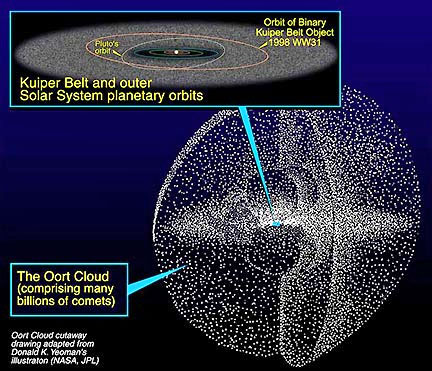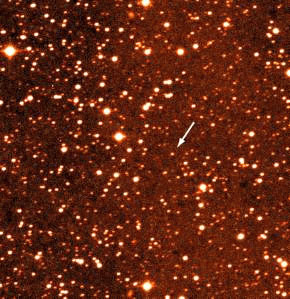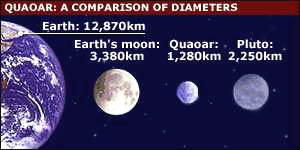Mike Brown, Ph.D., Assoc. Prof. of
Planetary Astronomy, California Institute of Technology,
Pasadena, California:
"The most significant aspect is that we
have found the largest object in the solar system since the
discovery of Pluto in 1930. What is clear to me is that the more
we look (in the Kuiper Belt), the more we find and the more we
look, the larger the objects we find.
The fact that we have only
looked for eight months through a small fraction of the sky and
found this object really says to me there is a pretty good
chance there will be larger and larger objects out there. As
Pluto was a very exciting discovery in 1930 showing that the
solar system extended further than originally thought, Quaoar (KWAW-waur) in June 2002 is showing the same thing, that
the solar system continues on further than people realized.
THERE CONTINUES TO BE THIS DEBATE ABOUT WHETHER PLUTO IS EVEN A
PLANET OR COULD BE A LARGE KUIPER BELT OBJECT. NOW, THIS OBJECT
IS ABOUT HALF THE SIZE?
It's about half the size of Pluto, right.
IF IT IS, WHY AREN'T THEY BOTH PUT IN THE CATEGORY OF KUIPER
PLANETOIDS?
I tell you what I would do. If I had a vote on how you would
classify both of these objects, I would say that a planet if
you want to be a planet, you should be significantly bigger than
anything else in your vicinity. Right now, Pluto is not
significantly bigger than anything in its vicinity because now
we know about Quaoar and we know that Pluto is not significantly
bigger.
So, I would classify both of those objects as
particularly large, but just as Kuiper Belt Objects, we now know
about 600 other Kuiper Belt Objects in orbits beyond Neptune and
these (Pluto and Quaoar) are just currently the two biggest
members.
WHAT EXACTLY ARE THE KUIPER BELT OBJECTS?
Kuiper Belt Objects are thought to be the remnant from the
earliest time in the solar system, about 4.5 billion years ago.
Then the solar system was a large gaseous nebula shaped like a
pancake, a flattened pancake, and planets were beginning to
form. Large planets formed close inside. Jupiter was the largest
planet that was formed inside. As we moved further out, Saturn,
Uranus, Neptune get progressively smaller.
By the time you get
out past Neptune, there is not enough material to form large
planets like those four small planets, so smaller objects form.
Smaller icy form and those objects would have formed about the
same time or a bit later than the giant gaseous planets and have
been sitting out there basically in deep freeze for the past 4.5
billion years.

Sun and solar
system are drawn inside Pluto's Orbit which is inside the Kuiper
Belt
that begins around the orbit of Neptune and extends outward
more than a billion miles toward the Oort Cloud made up of
billions of icy comets.
One of astronomy's great mysteries is
why there is a definedboundary for the Kuiper Belt,
a clear
separation from the more distant Oort Cloud.
Illustration
courtesy NASA and JPL.
HOW FAR IS THIS NEW QUAOAR?
Quaoar is about 4 billion miles from the sun.
THAT PLACES IT HOW FAR BEYOND PLUTO?
About a billion miles beyond Pluto. So it's quite a ways out
there.
IS IT AN AUSTRALIAN WORD?
No, the word is from the Tongva tribe indigenous to the Los
Angeles basin and it's the name of their creation force.
LIKE WHAT THEY WOULD SAY IS THE FORCE IN EVERYTHING?
Right. Quaoar is a formless, genderless, force that sang and
dance the entire universe into existence.
WHAT BROUGHT YOU ASTRONOMERS TO USE THAT NAME?
There is a name from the International Astronomical Union who
controls naming of all objects in the sky, that objects in the
Kuiper Belt like this one, have to be named after a creation
deity in some mythology. Some of the objects were named after
your generic Greek and Roman mythology. We thought it would be
much more interesting and appropriate to name it after the tribe
that was indigenous to the Los Angeles basin (near Pasadena and
Cal Tech where Mike Brown and his colleague, Chadwick Trujillo,
work to find Kuiper Belt Objects and discovered Quaoar.)
DO YOU THINK THERE ARE MORE KUIPER BELT OBJECTS AS LARGE, OR
EVEN LARGER, THAN THIS ONE?
I would be willing to bet that in the next year or two, we will
be finding objects at least this large and I even expect we will
be finding objects larger than Quaoar and probably even larger
than Pluto.
DOES THIS HAVE ANY CONNECTION TO ALL OF THE STORIES IN THE PAST
FEW YEARS ABOUT A PLANET X ORBITING PERHAPS FURTHER OUT IN THE OORT CLOUD. THERE IS A HYPOTHESIS THERE IS A BROWN DWARF OUT
THERE LEFT OVER FROM THE EARLY DAYS OF OUR SOLAR SYSTEM WHEN IT
STARTED OUT TO BE A BINARY STAR SYSTEM?
No connection. That hypothesis which is still open to a lot of
debate and is generally not accepted by most astronomers that
there is a large brown dwarf-like object quite a bit further
away. If there really is this brown dwarf, it's much more
massive than Quaoar. It's even more massive than Saturn, Uranus
or Neptune, probably. Maybe even Jupiter, probably even Jupiter.
So, if this object exists and I would say the jury is still
out if this object exists, it is much more massive and would
not feel any effects from Quaoar. It's also sufficiently far
away that Quaoar would not feel any effects from it.
This discovery does not really speak much to that one, except
this discovery of Quaoar is concrete. We see the object, we know
it's there, rather than just hypothesizing it from some fairly
subtle evidence.
WHICH HAS TO DO WITH THE IMPACT ON COMET ORBITS.
That's right.
NO INFLUENCE ON COMET PATHS?
No, it's probably too small unless a comet happened to come very
close by, the same way that Pluto is too small. We currently
don't know of any definite effects of Pluto on comet bodies or
other bodies coming by into the solar system.
WHY ARE YOU READY TO BET MONEY THAT THERE IS AN OBJECT IN THE
KUIPER BELT THAT IS AS LARGE, OR LARGER, THAN QUAOAR?
The reason is that we only started this survey of the outer
solar system eight months ago. And eight months since we started
the survey, we've covered maybe 5-10% of the sky. In that time,
we found Quaoar, we found in January an object not quite as big
as Quaoar, but about half the mass of Quaoar. There is a pretty
good chance there will be larger and larger objects out there.
ANY OTHER MYSTERY THAT YOU ARE
ESPECIALLY INTRIGUED ABOUT AND DISCUSSING WITH YOUR COLLEAGUES
IN THIS PLANETARY MEETING DOWN IN ALABAMA?
Yes, there is one big one and that is this. We know the Kuiper
Belt starts somewhere just outside the orbit of Neptune, but we
also know it ends fairly abruptly a little bit outside the orbit
of Quaoar. There is really no good reason why that should be the
case. All the original hypotheses about the existence of the
Kuiper Belt would have suggested that it extends much further
into space, and yet there seems to be a 'cliff' right there.
We
don't know why that is. We are trying many different ways to see
if there are other objects further out there. One of the
hypothesis might be that there are some particularly large
objects now I'm talking about planets, not Kuiper Belt Objects
large objects, maybe the size of Earth or Mars that are much
further out that are causing something that looks like this
edge to the known solar system. But for now, we don't know that.
All we know is that there is edge and we really would like to
know why that edge is there.
THE EDGE IS BETWEEN THE KUIPER BELT AND THE OORT CLOUD?
Right. The Oort cloud is much further out and it's composed of
objects that didn't form out there. They formed probably between
Jupiter and Saturn and then were flung much further out there.
WHAT YOU ARE SUGGESTING IS THAT THERE MIGHT BE A LARGE
PLANET-SIZED BODY STILL ROTATING OUR SOLAR SYSTEM THAT WE HAVE
YET TO DISCOVER THAT COULD BE AT THAT DISTANCE MARK BETWEEN THE
KUIPER BELT AND THE OORT CLOUD?
It's speculation, but it's speculation that I think is worth
considering. It's the type of thing with the survey we are
carrying out over the next few years, we should be able to
detect. I'm talking about something maybe the mass of Mars or
Earth.
GREAT COSMIC MYSTERIES, EVEN AT THE EDGES OF OUR OWN SOLAR
SYSTEM.
Yes, it's really quite fun!"



